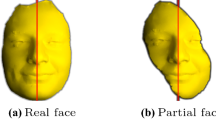Abstract
Automatic symmetry detection has received a significant amount of interest, which has resulted in a large number of proposed methods. This paper reports on our experiences while implementing the approach of Puget (CP2005, LNCS, vol. 3709, pp. 475–489. Springer, 2005). In particular, it proposes a modification to the approach to deal with general expressions, discusses the insights gained, and gives the results of an experimental evaluation of the accuracy and efficiency of the approach.
Similar content being viewed by others
Explore related subjects
Discover the latest articles, news and stories from top researchers in related subjects.References
Apt, K. R., & Wallace, M. G. (2006). Constraint logic programming using ECLiPSe. Cambridge University Press.
Cohen, D., Jeavons, P., Jefferson, C., Petrie, K. E., & Smith, B. M. (2005). Symmetry definitions for constraint satisfaction problems. In P. van Beek (Ed.), CP2005, LNCS (Vol. 3709, pp. 17–31). Springer.
Crawford, J., Ginsberg, M. L., Luck, E., & Roy, A. (1996). Symmetry-breaking predicates for search problems. In L. C. Aiello, J. Doyle, S. Shapiro (Eds.), KR’96: Principles of knowledge representation and reasoning (pp. 148–159). San Francisco, CA: Morgan Kaufmann.
Darga, P. T., Liffiton, M. H., Sakallah, K. A., & Markov, I. L. (2004). Exploiting structure in symmetry detection for CNF. In S. Malik, L. Fix, A. B. Kahng (Eds.), DAC (pp. 530–534). ACM.
Freuder, E. C. (1991). Eliminating interchangeable values in constraint satisfaction problems. In Proc. AAAI’91 (Vol. 1, pp. 227–233).
Frisch, A. M., Miguel, I., & Walsh, T. (2003). CGRASS: A system for transforming constraint satisfaction problems. In B. O’Sullivan (Ed.), Recent advances in constraints, joint ERCIM/CologNet international workshop on constraint solving and constraint logic programming, LNCS (Vol. 2627, pp. 15–30).
Gent, I. P., Harvey, W., & Kelsey, T. (2002). Groups and constraints: Symmetry breaking during search. In P. van Hentenryck (Ed.), CP2002, LNCS (Vol. 2470, pp. 415–430). Springer.
Gent, I. P., & Walsh, T. (1999). CSPLib: A benchmark library for constraints. Technical report, Technical report APES-09-1999. A shorter version appears in the proceedings of the 5th international conference on principles and practices of constraint programming (CP-99). Available from http://www.csplib.org/.
Jégou, P. (1993). Decomposition of domains based on the micro-structure of finite constraint satisfaction problems. In AAAI93: Proceedings of the 11th national conference on artificial intelligence (pp. 731–736).
McKay, B. D. (1981). Practical graph isomorphism. Congressus Numerantium, 30, 45–87.
Pearson, J., van Hentenryck, P., Flener, P., & Ȧgren, M. (2005). Compositional derivation of symmetries for constraint satisfaction. In Proceedings of the international symposium on abstraction, reformulation, and approximation (SARA’05).
Puget, J.-F. (2002). Symmetry breaking revisited. In P. Van Hentenryck (Ed.), CP2002, LNCS (Vol. 2470, pp. 446–461). Springer.
Puget, J.-F. (2005). Automatic detection of variable and value symmetries. P. van Beek (Ed.), CP2005, LNCS (Vol. 3709, pp. 475–489). Springer.
Puget, J.-F. (2005). Breaking all value symmetries in surjection problems. In P. van Beek (Ed.), CP2005, LNCS (Vol. 3709, pp. 490–504). Springer.
Ramani, A., & Markov, I. L. (2004). Automatically exploiting symmetries in constraint programming. In B. Faltings, A. Petcu, F. Fages, F. Rossi (Eds.), CSCLP (Vol. 3419, pp. 98–112).
Roy, P., & Pachet, F. (1998). Using symmetry of global constraints to speed up the resolution of constraint satisfaction problems. In ECAI98 workshop on non-binary constraints (pp. 27–33).
Author information
Authors and Affiliations
Corresponding author
Rights and permissions
About this article
Cite this article
Mears, C., Garcia de la Banda, M. & Wallace, M. On implementing symmetry detection. Constraints 14, 443–477 (2009). https://doi.org/10.1007/s10601-008-9057-9
Published:
Issue Date:
DOI: https://doi.org/10.1007/s10601-008-9057-9




